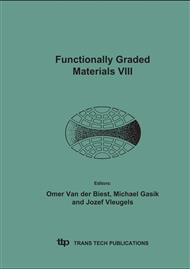p.145
p.151
p.157
p.163
p.171
p.177
p.183
p.189
p.195
Manufacturing of Structured TiO2-Surfaces for Cell Carrier Application
Abstract:
Titania surfaces were produced via a combined tape and slurry casting process. They were structured in the mm-µm range using structuring the gypsum, embossing the green ceramic, and lasering the sintered ceramic. The resulting structures were analyzed upon surface roughness and optically characterized by SEM. The ra values lay between 19-28 µm. Fibroblasts were seeded onto these structures, incubated for one and three days, and the number of cells was compared using polystyrol petri-dishes and borosilicate glass cover slips as references. It was demonstrated that the structure of the ceramic had an influence on the cell behaviour: larger cell numbers could be observed for the structured ceramics.
Info:
Periodical:
Pages:
171-176
Citation:
Online since:
August 2005
Keywords:
Price:
Сopyright:
© 2005 Trans Tech Publications Ltd. All Rights Reserved
Share:
Citation:


